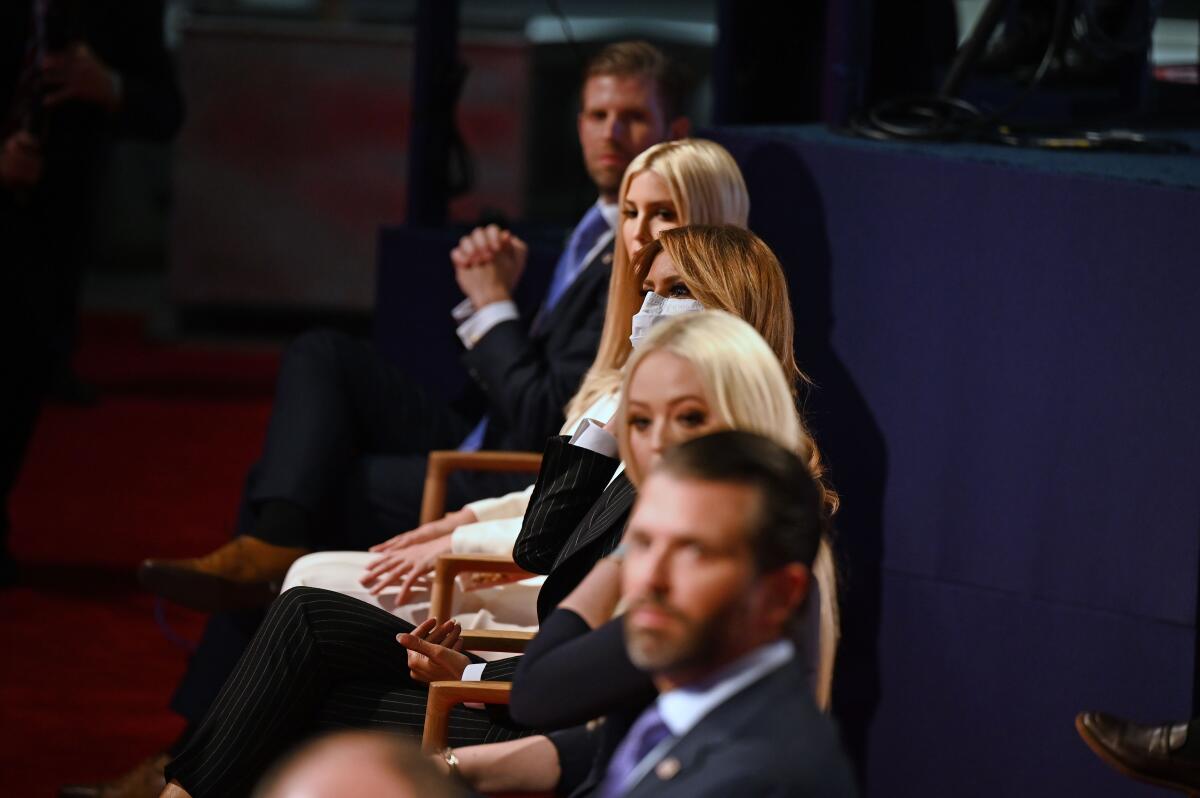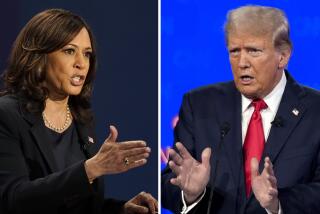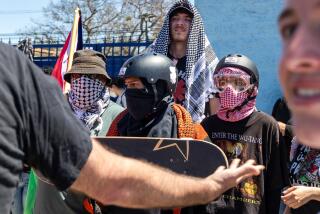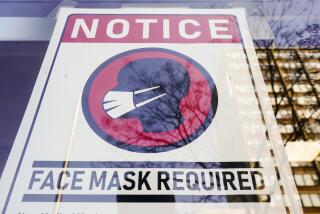Note to the Trump family: Wear your damn masks

- Share via
As the guests arrive at the vice presidential debate Wednesday evening, my guess is that they’ll not only be directed to wear face masks but they’ll actually have to do it. That would be a nice change.
At the presidential debate last week at Case Western Reserve University and the renowned Cleveland Clinic, the Trump family and several top aides not only sat in the audience unmasked, but they also rejected masks when offered by a clinic staffer. Yet masks were among the rules set down for the event.
No real surprise ― these are people who routinely think the rules weren’t made for them. But what is surprising is that the staff let them get away with it. They probably figured that with every attendee being tested no more than 72 hours before the debate, risks were low. They certainly were intimidated by the big-name guests and the trouble that might ensue if they tried to compel the VIPs to don masks.
But we know — or at least everyone should know — that COVID-19 tests are not a reliable indicator of infections that have only recently taken root. Instead, they are best able to detect infections that occurred at least four or five days beforehand. It takes a while for virus in the infected person’s body to rise to detectable levels.
The bigger and simpler point, whether you’re front row at a debate or visiting a newly reopened museum, is that masks work. Perhaps you’ve heard of the study involving two infected and symptomatic hairdressers who wore masks at their salon and worked on 139 clients between them, indoors and close up? None of the clients became infected. Neither did any of the other stylists or their customers. Yet when one of the hairdressers was at home with family, mask off, her relatives got sick. So she was clearly able to transmit the disease.
Masks prevent virus-carrying droplets from landing on people and surfaces, and they reduce aerosol transmission. They’ve made it possible for people to shop more safely, fly more safely, go to the doctor more safely. And they make attendance at a debate safer.
Not that the Trump family should have been compelled to wear masks that evening. No, not at all. They simply should have been escorted out of the room when they refused.
Along with anyone else who can’t seem to get the importance of wearing masks.
Sadly, the Trumps are just a more spoiled and haughty version of what we’re seeing in many places around the country. Even when there are rules about masks, the rules are only as good as the number of people willing to follow them. Enforcement is near nil.
We see it all the time on local streets. Or even at my local drugstore, where the cashiers had their masks on firmly ― under their noses. Including the one behind the prescription counter. A shopper there with a broken mask held it up to her face with one hand until she saw cosmetic displays she wanted to touch, at which point the hands she’d been using to hold her mask were used to handle the items while the mask dangled usefully from her wrist.
I recently needed to travel to Washington, D.C., where, in contrast to my local neighborhoods, almost everyone wore masks on the street. Even college students, generally thought to be heedless. Even people who were at least 100 feet from the nearest human. Not the people in the White House, obviously, but the people of the city.
In the airports, the situations were reversed. People in the Los Angeles International terminal were masked. But no matter where I tried to sit at Ronald Reagan Washington National Airport in D.C., someone would plunk themselves down within a couple of feet without a mask, or with a mask halfway off their faces. Or they would eat a small bag of chips, which is allowed without a mask. For 45 minutes, though? One. Chip. Every. Four. Minutes.
After my fourth seat change, when I was running out of places to sit, a man plopped down across from me, his mask hanging from one ear. I asked politely if he would mind masking. He stared at me.
So I walked off again ― this time to ask an airport employee whether I’d gotten the rules all wrong. (In fairness, most of the people in the airport had their faces covered.)
She wasn’t interested in getting involved as she glanced at the man 10 feet away without his mask. “Those people he’s sitting near might be relatives,” she said. “Maybe he’s getting ready to eat or drink something.” He wasn’t, and it doesn’t matter who the people near him were.
I can’t blame her, though. Store employees have been shot for asking customers to put on masks. Why create a scene when that person, or any other unmasked person in the enclosed space of an air terminal, probably isn’t infected? Why embarrass the Trumps by requiring them to mask up or get out?
Because of this: We now know that too often someone we didn’t expect to be infected ― like, say, the president or his wife ― might well have the illness when they venture out in public. And since the Centers for Disease Control and Prevention has finally acknowledged the science and admitted that COVID-19 also is spread by aerosols that can remain suspended in the air for hours, we know that social distancing is not enough, not in enclosed spaces with less-than-stellar ventilation. Indoors, it’s not just about the distance a droplet can travel before it falls to the ground.
Masks have offered us a major reprieve. As someone with somewhat elevated risk, I wouldn’t have felt reasonably safe flying without them. People would be far less safe in stores. Masks are allowing our economy to reopen, albeit slowly. And wearing them up to the bridge of the nose is an important part of the equation. There’s a reason why so many tests for COVID-19 involve a swab up the nostrils. In infected people, the sinus cavities are loaded with virus.
Masks will make the vice presidential debate in Salt Lake City safer as well. The new protocols include plexiglass partitions for candidates Sen. Kamala Harris (D-Calif.) and Vice President Mike Pence, 12 feet of separation between their podiums and blue surgical masks for everyone in the audience, to be worn at all times. This time, and for any future debates, there should be no exemptions. VIPs are just as capable of spreading this potentially deadly infection as anyone else.
The same should go for settings where masks are required. Shorter days, inclement weather and thus more time spent indoors are coming soon. We’re in for a rough winter if people keep thinking they can’t possibly be putting others at risk ― or don’t care if they do.
More to Read
A cure for the common opinion
Get thought-provoking perspectives with our weekly newsletter.
You may occasionally receive promotional content from the Los Angeles Times.










